Analyzing Starbucks' Global Expansion and Market Strategies
VerifiedAdded on 2020/04/15
|9
|1625
|157
AI Summary
The assignment explores the strategies employed by Starbucks to enhance competitiveness and achieve global expansion, focusing on opening more outlets in regions like China and Asia Pacific. It examines Starbucks’ market segmentation both geographically and demographically, highlighting its positioning as a premium coffee brand offering unique customer experiences. The analysis includes financial performance metrics such as sales growth, return on equity, operating margins, and debt-to-equity ratios to assess the effectiveness of Starbucks' strategic initiatives. This evaluation is based on data from Starbucks’ audited annual financial statements, providing insights into the company's current market stance and future potential.
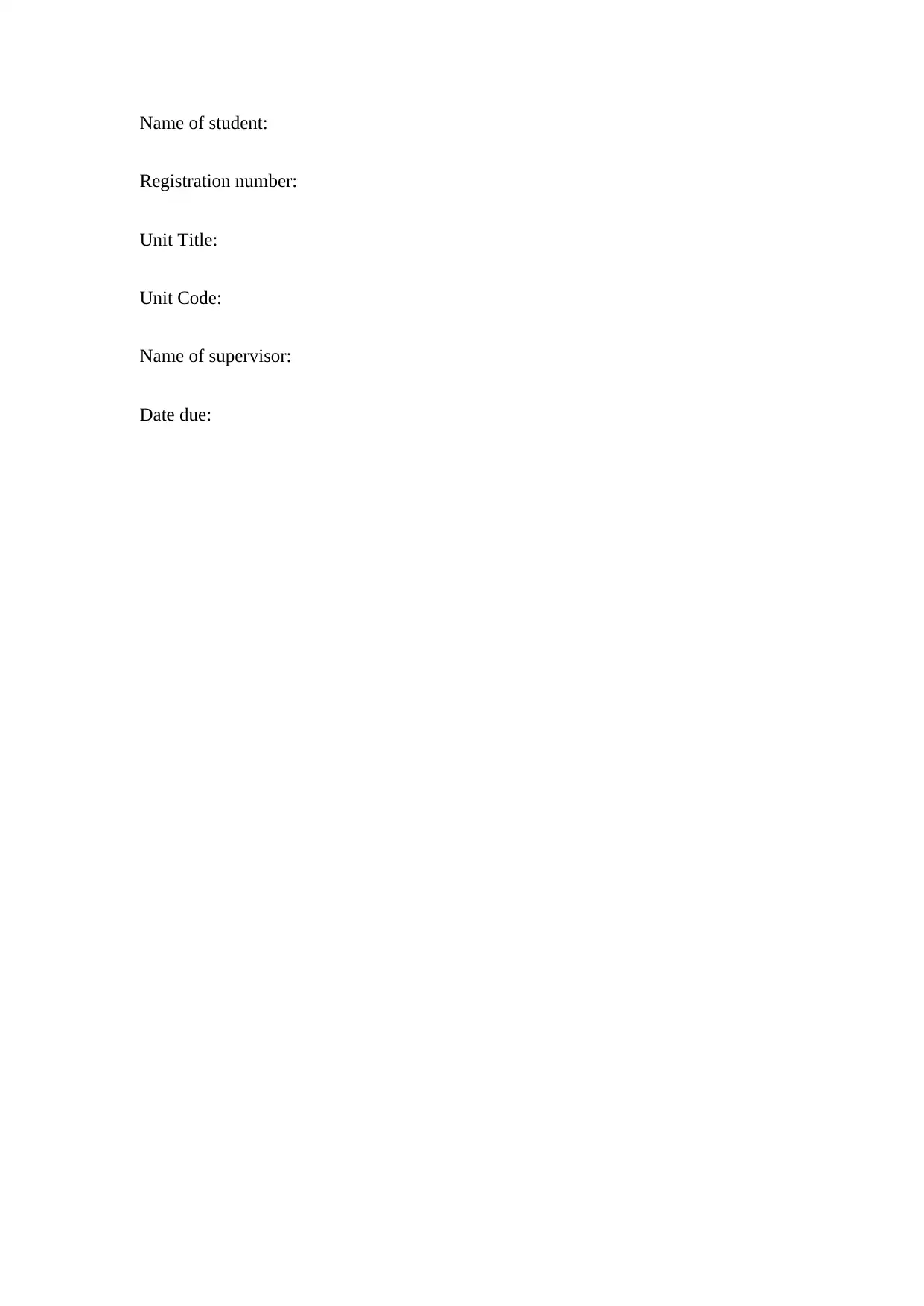
Name of student:
Registration number:
Unit Title:
Unit Code:
Name of supervisor:
Date due:
Registration number:
Unit Title:
Unit Code:
Name of supervisor:
Date due:
Paraphrase This Document
Need a fresh take? Get an instant paraphrase of this document with our AI Paraphraser
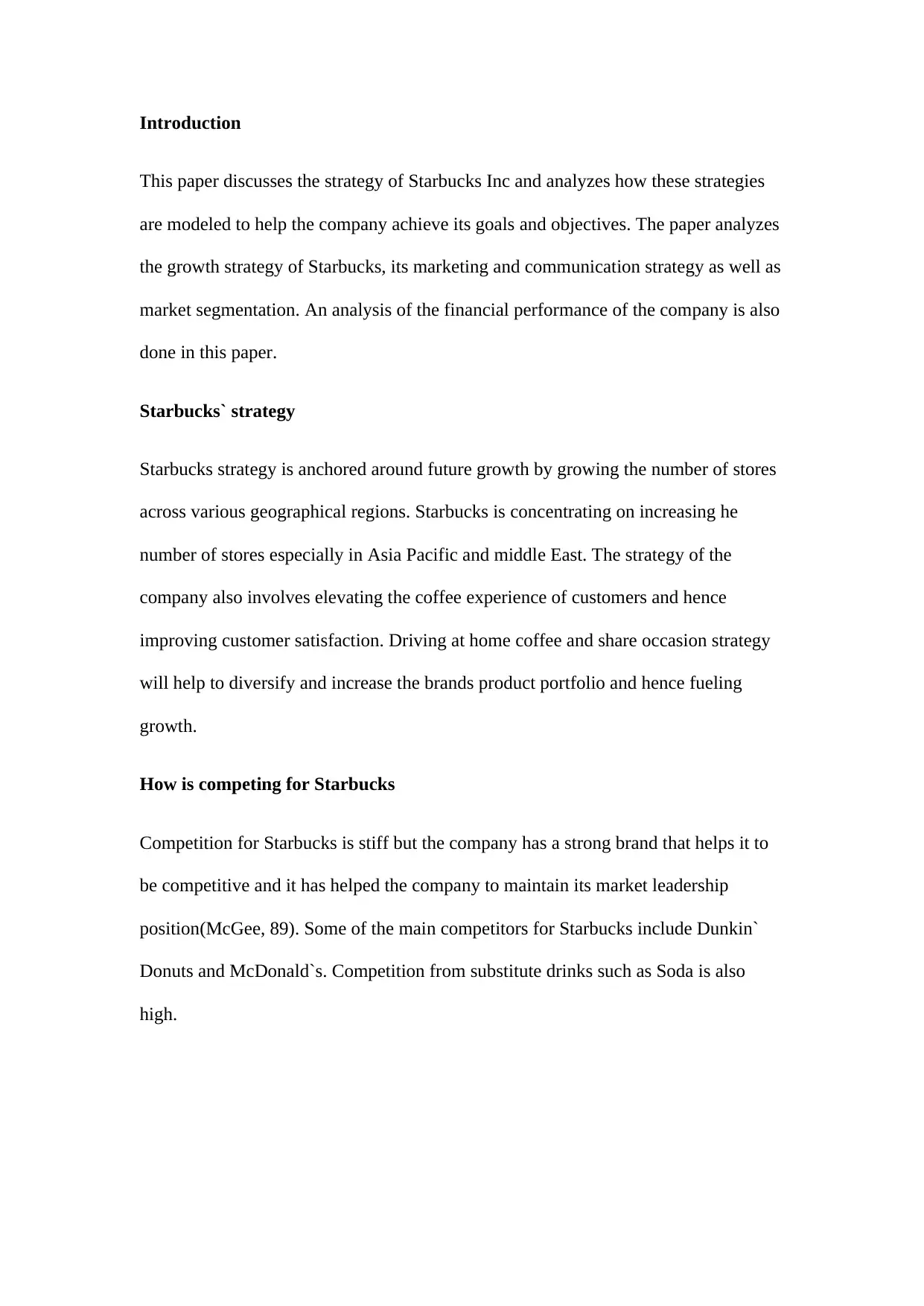
Introduction
This paper discusses the strategy of Starbucks Inc and analyzes how these strategies
are modeled to help the company achieve its goals and objectives. The paper analyzes
the growth strategy of Starbucks, its marketing and communication strategy as well as
market segmentation. An analysis of the financial performance of the company is also
done in this paper.
Starbucks` strategy
Starbucks strategy is anchored around future growth by growing the number of stores
across various geographical regions. Starbucks is concentrating on increasing he
number of stores especially in Asia Pacific and middle East. The strategy of the
company also involves elevating the coffee experience of customers and hence
improving customer satisfaction. Driving at home coffee and share occasion strategy
will help to diversify and increase the brands product portfolio and hence fueling
growth.
How is competing for Starbucks
Competition for Starbucks is stiff but the company has a strong brand that helps it to
be competitive and it has helped the company to maintain its market leadership
position(McGee, 89). Some of the main competitors for Starbucks include Dunkin`
Donuts and McDonald`s. Competition from substitute drinks such as Soda is also
high.
This paper discusses the strategy of Starbucks Inc and analyzes how these strategies
are modeled to help the company achieve its goals and objectives. The paper analyzes
the growth strategy of Starbucks, its marketing and communication strategy as well as
market segmentation. An analysis of the financial performance of the company is also
done in this paper.
Starbucks` strategy
Starbucks strategy is anchored around future growth by growing the number of stores
across various geographical regions. Starbucks is concentrating on increasing he
number of stores especially in Asia Pacific and middle East. The strategy of the
company also involves elevating the coffee experience of customers and hence
improving customer satisfaction. Driving at home coffee and share occasion strategy
will help to diversify and increase the brands product portfolio and hence fueling
growth.
How is competing for Starbucks
Competition for Starbucks is stiff but the company has a strong brand that helps it to
be competitive and it has helped the company to maintain its market leadership
position(McGee, 89). Some of the main competitors for Starbucks include Dunkin`
Donuts and McDonald`s. Competition from substitute drinks such as Soda is also
high.
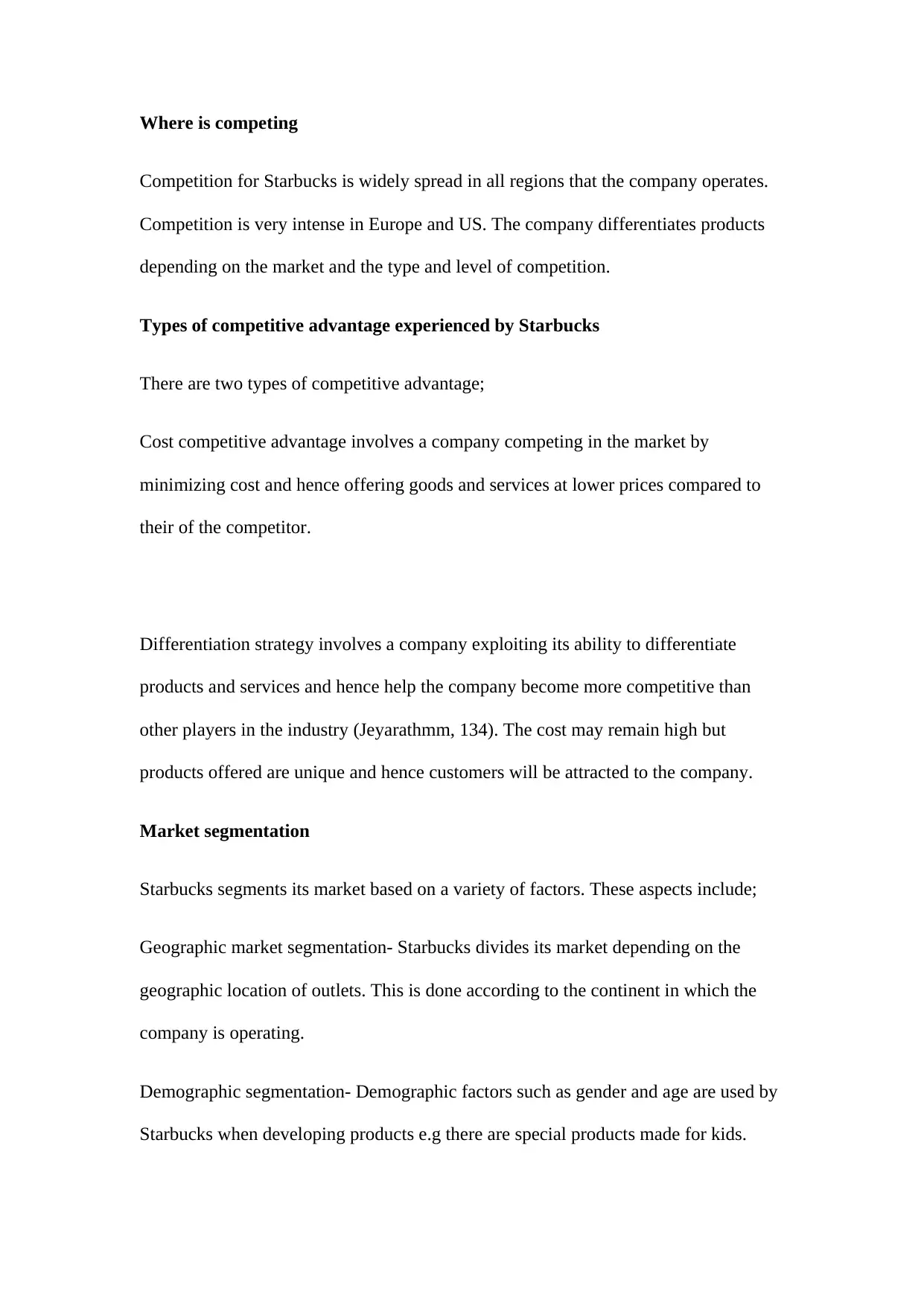
Where is competing
Competition for Starbucks is widely spread in all regions that the company operates.
Competition is very intense in Europe and US. The company differentiates products
depending on the market and the type and level of competition.
Types of competitive advantage experienced by Starbucks
There are two types of competitive advantage;
Cost competitive advantage involves a company competing in the market by
minimizing cost and hence offering goods and services at lower prices compared to
their of the competitor.
Differentiation strategy involves a company exploiting its ability to differentiate
products and services and hence help the company become more competitive than
other players in the industry (Jeyarathmm, 134). The cost may remain high but
products offered are unique and hence customers will be attracted to the company.
Market segmentation
Starbucks segments its market based on a variety of factors. These aspects include;
Geographic market segmentation- Starbucks divides its market depending on the
geographic location of outlets. This is done according to the continent in which the
company is operating.
Demographic segmentation- Demographic factors such as gender and age are used by
Starbucks when developing products e.g there are special products made for kids.
Competition for Starbucks is widely spread in all regions that the company operates.
Competition is very intense in Europe and US. The company differentiates products
depending on the market and the type and level of competition.
Types of competitive advantage experienced by Starbucks
There are two types of competitive advantage;
Cost competitive advantage involves a company competing in the market by
minimizing cost and hence offering goods and services at lower prices compared to
their of the competitor.
Differentiation strategy involves a company exploiting its ability to differentiate
products and services and hence help the company become more competitive than
other players in the industry (Jeyarathmm, 134). The cost may remain high but
products offered are unique and hence customers will be attracted to the company.
Market segmentation
Starbucks segments its market based on a variety of factors. These aspects include;
Geographic market segmentation- Starbucks divides its market depending on the
geographic location of outlets. This is done according to the continent in which the
company is operating.
Demographic segmentation- Demographic factors such as gender and age are used by
Starbucks when developing products e.g there are special products made for kids.
⊘ This is a preview!⊘
Do you want full access?
Subscribe today to unlock all pages.

Trusted by 1+ million students worldwide
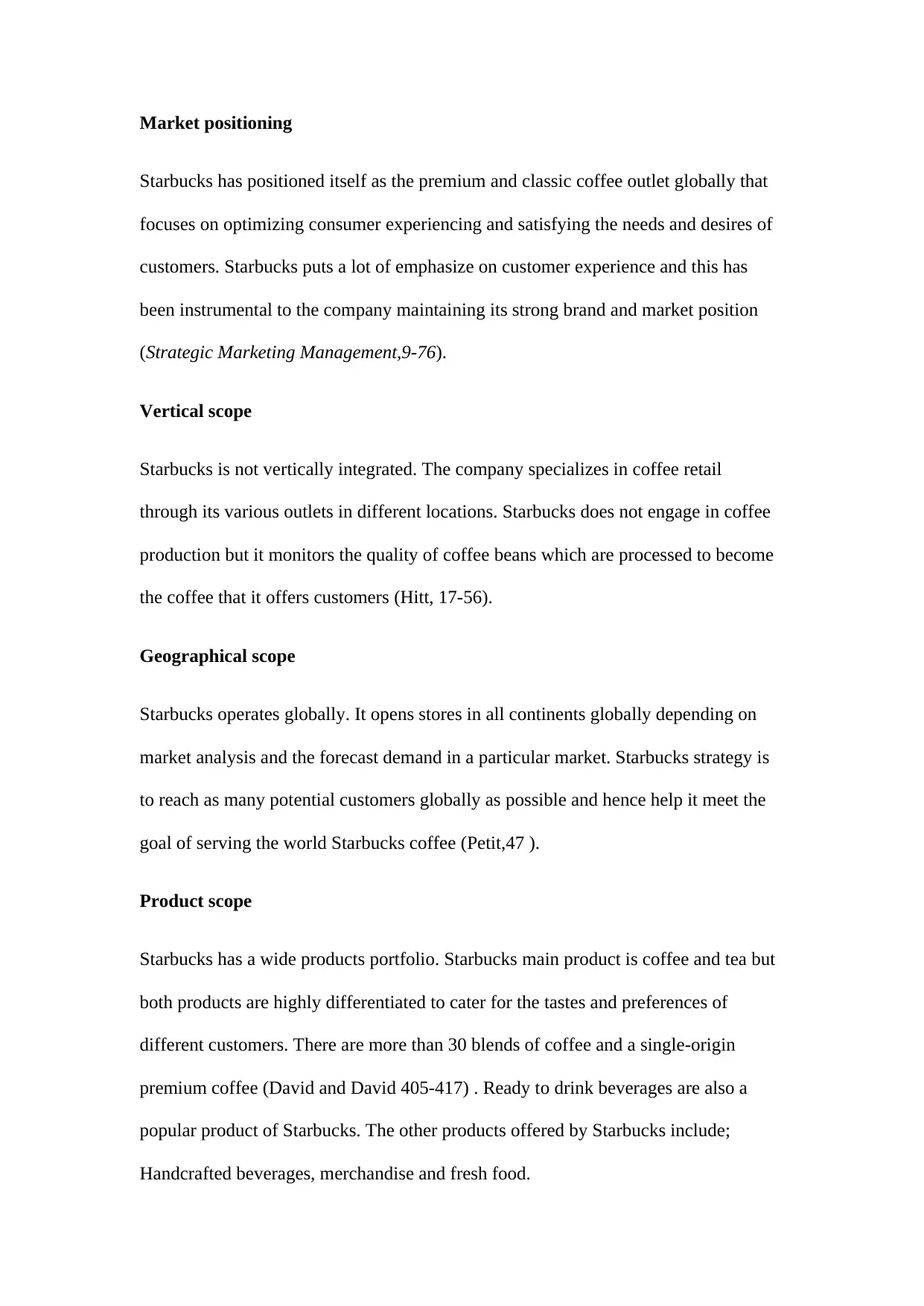
Market positioning
Starbucks has positioned itself as the premium and classic coffee outlet globally that
focuses on optimizing consumer experiencing and satisfying the needs and desires of
customers. Starbucks puts a lot of emphasize on customer experience and this has
been instrumental to the company maintaining its strong brand and market position
(Strategic Marketing Management,9-76).
Vertical scope
Starbucks is not vertically integrated. The company specializes in coffee retail
through its various outlets in different locations. Starbucks does not engage in coffee
production but it monitors the quality of coffee beans which are processed to become
the coffee that it offers customers (Hitt, 17-56).
Geographical scope
Starbucks operates globally. It opens stores in all continents globally depending on
market analysis and the forecast demand in a particular market. Starbucks strategy is
to reach as many potential customers globally as possible and hence help it meet the
goal of serving the world Starbucks coffee (Petit,47 ).
Product scope
Starbucks has a wide products portfolio. Starbucks main product is coffee and tea but
both products are highly differentiated to cater for the tastes and preferences of
different customers. There are more than 30 blends of coffee and a single-origin
premium coffee (David and David 405-417) . Ready to drink beverages are also a
popular product of Starbucks. The other products offered by Starbucks include;
Handcrafted beverages, merchandise and fresh food.
Starbucks has positioned itself as the premium and classic coffee outlet globally that
focuses on optimizing consumer experiencing and satisfying the needs and desires of
customers. Starbucks puts a lot of emphasize on customer experience and this has
been instrumental to the company maintaining its strong brand and market position
(Strategic Marketing Management,9-76).
Vertical scope
Starbucks is not vertically integrated. The company specializes in coffee retail
through its various outlets in different locations. Starbucks does not engage in coffee
production but it monitors the quality of coffee beans which are processed to become
the coffee that it offers customers (Hitt, 17-56).
Geographical scope
Starbucks operates globally. It opens stores in all continents globally depending on
market analysis and the forecast demand in a particular market. Starbucks strategy is
to reach as many potential customers globally as possible and hence help it meet the
goal of serving the world Starbucks coffee (Petit,47 ).
Product scope
Starbucks has a wide products portfolio. Starbucks main product is coffee and tea but
both products are highly differentiated to cater for the tastes and preferences of
different customers. There are more than 30 blends of coffee and a single-origin
premium coffee (David and David 405-417) . Ready to drink beverages are also a
popular product of Starbucks. The other products offered by Starbucks include;
Handcrafted beverages, merchandise and fresh food.
Paraphrase This Document
Need a fresh take? Get an instant paraphrase of this document with our AI Paraphraser
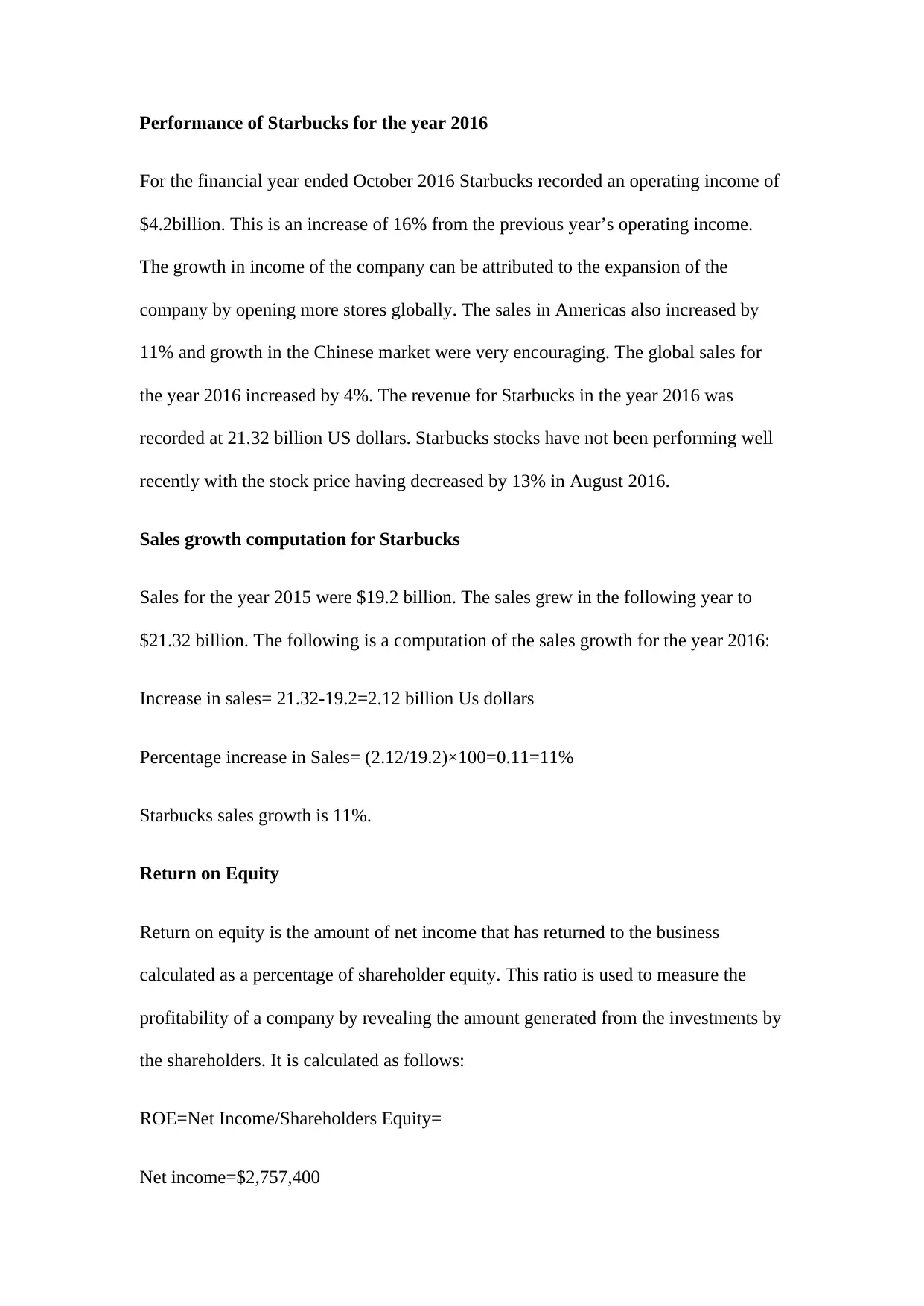
Performance of Starbucks for the year 2016
For the financial year ended October 2016 Starbucks recorded an operating income of
$4.2billion. This is an increase of 16% from the previous year’s operating income.
The growth in income of the company can be attributed to the expansion of the
company by opening more stores globally. The sales in Americas also increased by
11% and growth in the Chinese market were very encouraging. The global sales for
the year 2016 increased by 4%. The revenue for Starbucks in the year 2016 was
recorded at 21.32 billion US dollars. Starbucks stocks have not been performing well
recently with the stock price having decreased by 13% in August 2016.
Sales growth computation for Starbucks
Sales for the year 2015 were $19.2 billion. The sales grew in the following year to
$21.32 billion. The following is a computation of the sales growth for the year 2016:
Increase in sales= 21.32-19.2=2.12 billion Us dollars
Percentage increase in Sales= (2.12/19.2)×100=0.11=11%
Starbucks sales growth is 11%.
Return on Equity
Return on equity is the amount of net income that has returned to the business
calculated as a percentage of shareholder equity. This ratio is used to measure the
profitability of a company by revealing the amount generated from the investments by
the shareholders. It is calculated as follows:
ROE=Net Income/Shareholders Equity=
Net income=$2,757,400
For the financial year ended October 2016 Starbucks recorded an operating income of
$4.2billion. This is an increase of 16% from the previous year’s operating income.
The growth in income of the company can be attributed to the expansion of the
company by opening more stores globally. The sales in Americas also increased by
11% and growth in the Chinese market were very encouraging. The global sales for
the year 2016 increased by 4%. The revenue for Starbucks in the year 2016 was
recorded at 21.32 billion US dollars. Starbucks stocks have not been performing well
recently with the stock price having decreased by 13% in August 2016.
Sales growth computation for Starbucks
Sales for the year 2015 were $19.2 billion. The sales grew in the following year to
$21.32 billion. The following is a computation of the sales growth for the year 2016:
Increase in sales= 21.32-19.2=2.12 billion Us dollars
Percentage increase in Sales= (2.12/19.2)×100=0.11=11%
Starbucks sales growth is 11%.
Return on Equity
Return on equity is the amount of net income that has returned to the business
calculated as a percentage of shareholder equity. This ratio is used to measure the
profitability of a company by revealing the amount generated from the investments by
the shareholders. It is calculated as follows:
ROE=Net Income/Shareholders Equity=
Net income=$2,757,400
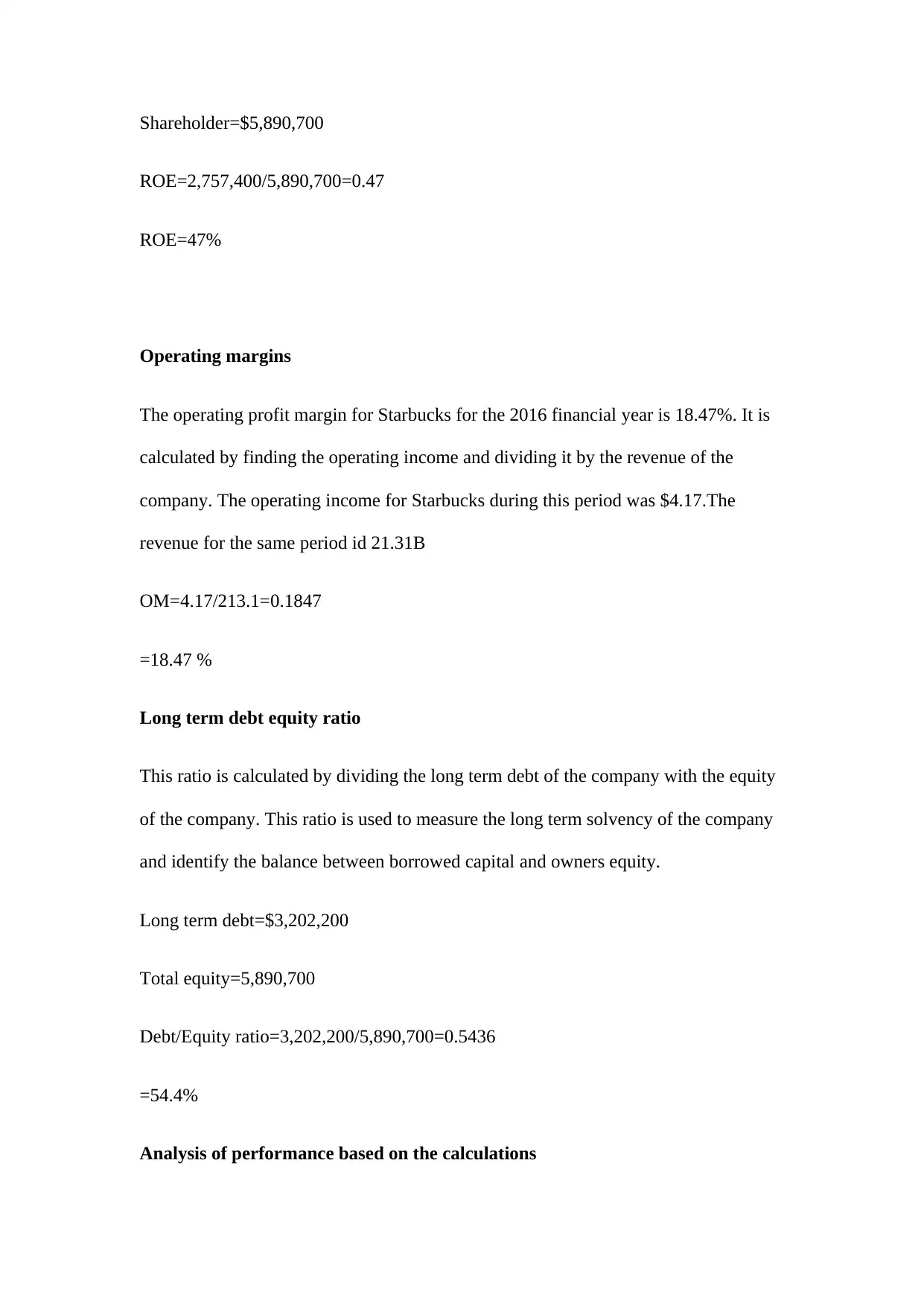
Shareholder=$5,890,700
ROE=2,757,400/5,890,700=0.47
ROE=47%
Operating margins
The operating profit margin for Starbucks for the 2016 financial year is 18.47%. It is
calculated by finding the operating income and dividing it by the revenue of the
company. The operating income for Starbucks during this period was $4.17.The
revenue for the same period id 21.31B
OM=4.17/213.1=0.1847
=18.47 %
Long term debt equity ratio
This ratio is calculated by dividing the long term debt of the company with the equity
of the company. This ratio is used to measure the long term solvency of the company
and identify the balance between borrowed capital and owners equity.
Long term debt=$3,202,200
Total equity=5,890,700
Debt/Equity ratio=3,202,200/5,890,700=0.5436
=54.4%
Analysis of performance based on the calculations
ROE=2,757,400/5,890,700=0.47
ROE=47%
Operating margins
The operating profit margin for Starbucks for the 2016 financial year is 18.47%. It is
calculated by finding the operating income and dividing it by the revenue of the
company. The operating income for Starbucks during this period was $4.17.The
revenue for the same period id 21.31B
OM=4.17/213.1=0.1847
=18.47 %
Long term debt equity ratio
This ratio is calculated by dividing the long term debt of the company with the equity
of the company. This ratio is used to measure the long term solvency of the company
and identify the balance between borrowed capital and owners equity.
Long term debt=$3,202,200
Total equity=5,890,700
Debt/Equity ratio=3,202,200/5,890,700=0.5436
=54.4%
Analysis of performance based on the calculations
⊘ This is a preview!⊘
Do you want full access?
Subscribe today to unlock all pages.

Trusted by 1+ million students worldwide
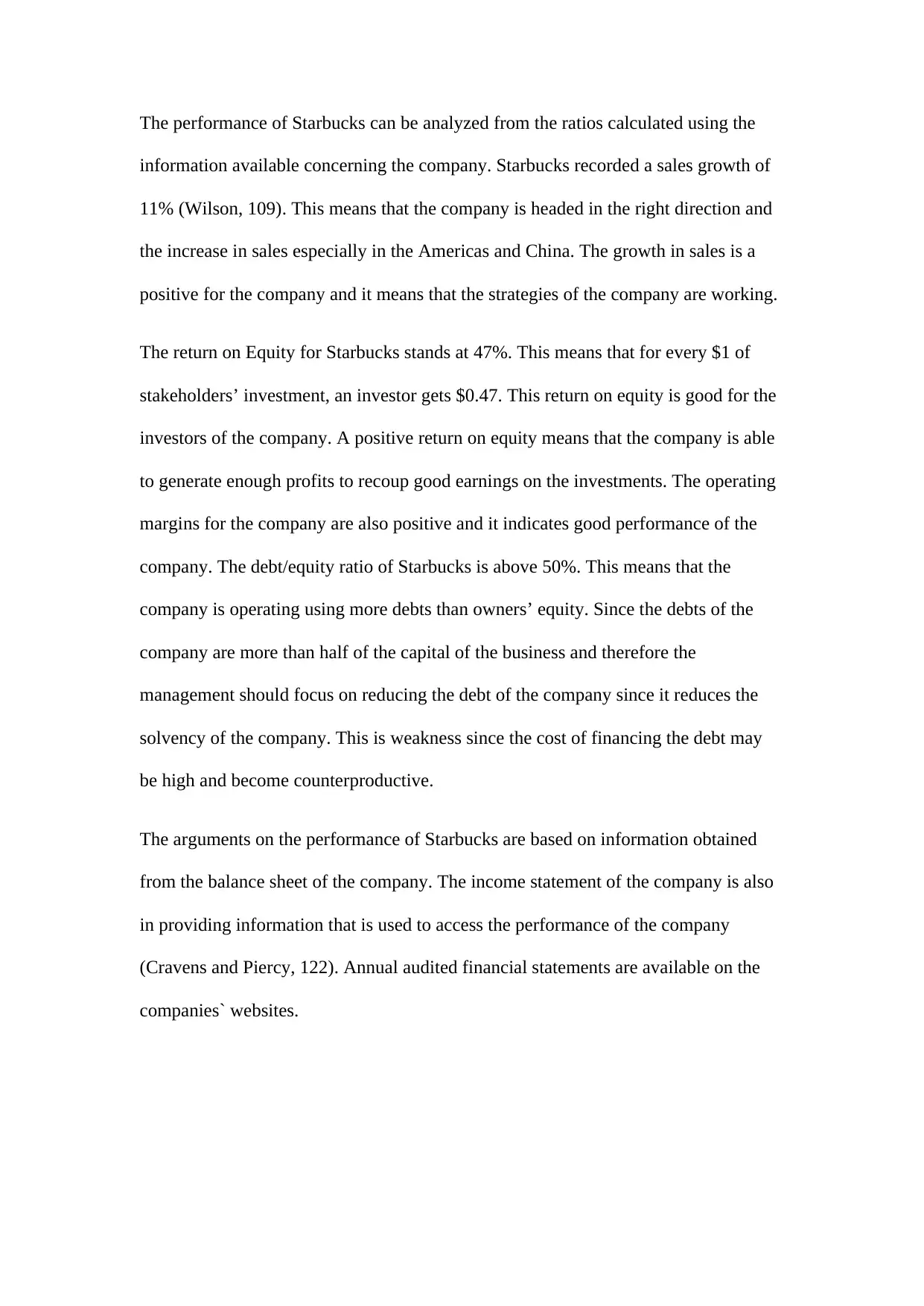
The performance of Starbucks can be analyzed from the ratios calculated using the
information available concerning the company. Starbucks recorded a sales growth of
11% (Wilson, 109). This means that the company is headed in the right direction and
the increase in sales especially in the Americas and China. The growth in sales is a
positive for the company and it means that the strategies of the company are working.
The return on Equity for Starbucks stands at 47%. This means that for every $1 of
stakeholders’ investment, an investor gets $0.47. This return on equity is good for the
investors of the company. A positive return on equity means that the company is able
to generate enough profits to recoup good earnings on the investments. The operating
margins for the company are also positive and it indicates good performance of the
company. The debt/equity ratio of Starbucks is above 50%. This means that the
company is operating using more debts than owners’ equity. Since the debts of the
company are more than half of the capital of the business and therefore the
management should focus on reducing the debt of the company since it reduces the
solvency of the company. This is weakness since the cost of financing the debt may
be high and become counterproductive.
The arguments on the performance of Starbucks are based on information obtained
from the balance sheet of the company. The income statement of the company is also
in providing information that is used to access the performance of the company
(Cravens and Piercy, 122). Annual audited financial statements are available on the
companies` websites.
information available concerning the company. Starbucks recorded a sales growth of
11% (Wilson, 109). This means that the company is headed in the right direction and
the increase in sales especially in the Americas and China. The growth in sales is a
positive for the company and it means that the strategies of the company are working.
The return on Equity for Starbucks stands at 47%. This means that for every $1 of
stakeholders’ investment, an investor gets $0.47. This return on equity is good for the
investors of the company. A positive return on equity means that the company is able
to generate enough profits to recoup good earnings on the investments. The operating
margins for the company are also positive and it indicates good performance of the
company. The debt/equity ratio of Starbucks is above 50%. This means that the
company is operating using more debts than owners’ equity. Since the debts of the
company are more than half of the capital of the business and therefore the
management should focus on reducing the debt of the company since it reduces the
solvency of the company. This is weakness since the cost of financing the debt may
be high and become counterproductive.
The arguments on the performance of Starbucks are based on information obtained
from the balance sheet of the company. The income statement of the company is also
in providing information that is used to access the performance of the company
(Cravens and Piercy, 122). Annual audited financial statements are available on the
companies` websites.
Paraphrase This Document
Need a fresh take? Get an instant paraphrase of this document with our AI Paraphraser
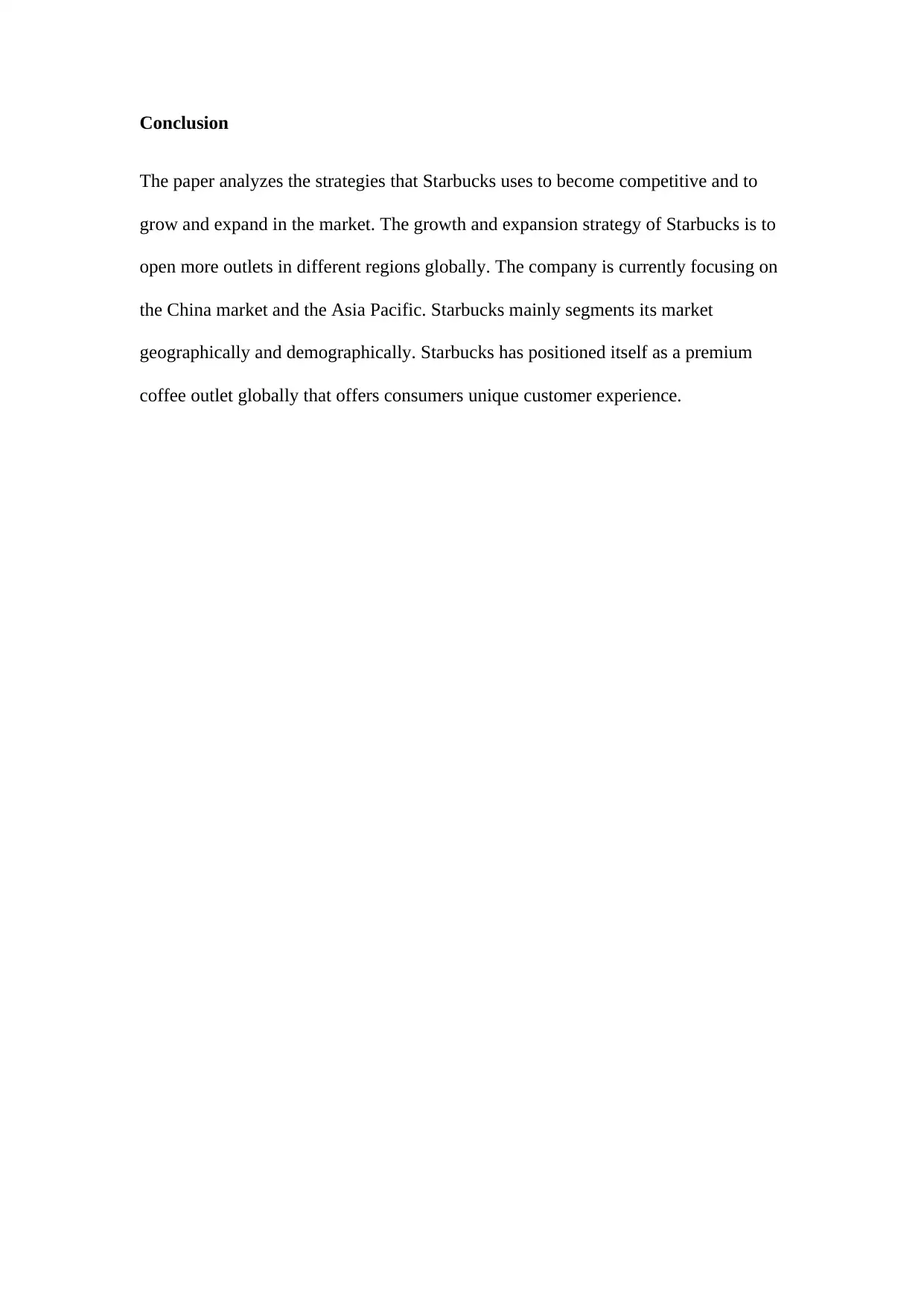
Conclusion
The paper analyzes the strategies that Starbucks uses to become competitive and to
grow and expand in the market. The growth and expansion strategy of Starbucks is to
open more outlets in different regions globally. The company is currently focusing on
the China market and the Asia Pacific. Starbucks mainly segments its market
geographically and demographically. Starbucks has positioned itself as a premium
coffee outlet globally that offers consumers unique customer experience.
The paper analyzes the strategies that Starbucks uses to become competitive and to
grow and expand in the market. The growth and expansion strategy of Starbucks is to
open more outlets in different regions globally. The company is currently focusing on
the China market and the Asia Pacific. Starbucks mainly segments its market
geographically and demographically. Starbucks has positioned itself as a premium
coffee outlet globally that offers consumers unique customer experience.
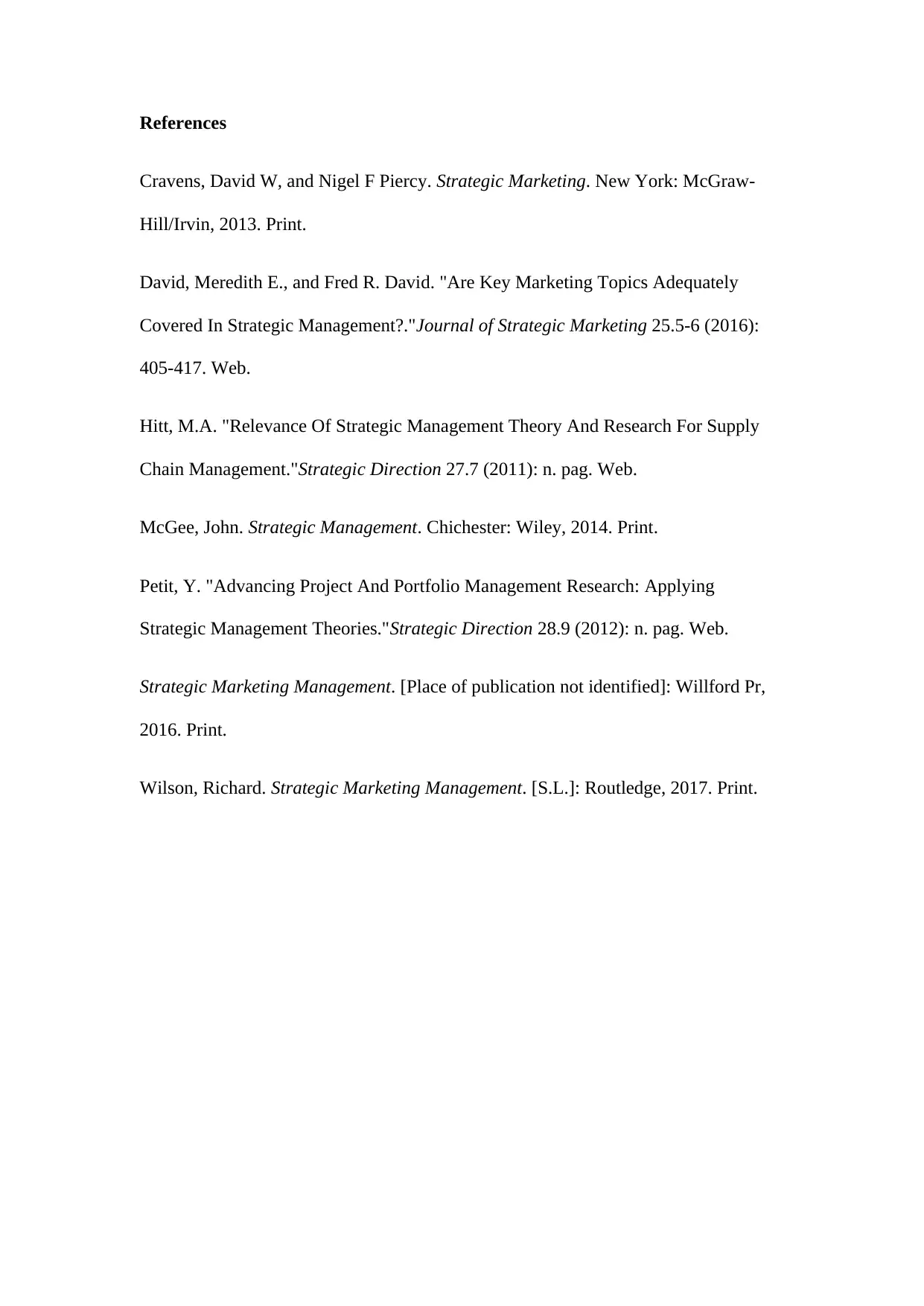
References
Cravens, David W, and Nigel F Piercy. Strategic Marketing. New York: McGraw-
Hill/Irvin, 2013. Print.
David, Meredith E., and Fred R. David. "Are Key Marketing Topics Adequately
Covered In Strategic Management?."Journal of Strategic Marketing 25.5-6 (2016):
405-417. Web.
Hitt, M.A. "Relevance Of Strategic Management Theory And Research For Supply
Chain Management."Strategic Direction 27.7 (2011): n. pag. Web.
McGee, John. Strategic Management. Chichester: Wiley, 2014. Print.
Petit, Y. "Advancing Project And Portfolio Management Research: Applying
Strategic Management Theories."Strategic Direction 28.9 (2012): n. pag. Web.
Strategic Marketing Management. [Place of publication not identified]: Willford Pr,
2016. Print.
Wilson, Richard. Strategic Marketing Management. [S.L.]: Routledge, 2017. Print.
Cravens, David W, and Nigel F Piercy. Strategic Marketing. New York: McGraw-
Hill/Irvin, 2013. Print.
David, Meredith E., and Fred R. David. "Are Key Marketing Topics Adequately
Covered In Strategic Management?."Journal of Strategic Marketing 25.5-6 (2016):
405-417. Web.
Hitt, M.A. "Relevance Of Strategic Management Theory And Research For Supply
Chain Management."Strategic Direction 27.7 (2011): n. pag. Web.
McGee, John. Strategic Management. Chichester: Wiley, 2014. Print.
Petit, Y. "Advancing Project And Portfolio Management Research: Applying
Strategic Management Theories."Strategic Direction 28.9 (2012): n. pag. Web.
Strategic Marketing Management. [Place of publication not identified]: Willford Pr,
2016. Print.
Wilson, Richard. Strategic Marketing Management. [S.L.]: Routledge, 2017. Print.
⊘ This is a preview!⊘
Do you want full access?
Subscribe today to unlock all pages.

Trusted by 1+ million students worldwide
1 out of 9
Related Documents
Your All-in-One AI-Powered Toolkit for Academic Success.
+13062052269
info@desklib.com
Available 24*7 on WhatsApp / Email
![[object Object]](/_next/static/media/star-bottom.7253800d.svg)
Unlock your academic potential
Copyright © 2020–2025 A2Z Services. All Rights Reserved. Developed and managed by ZUCOL.





